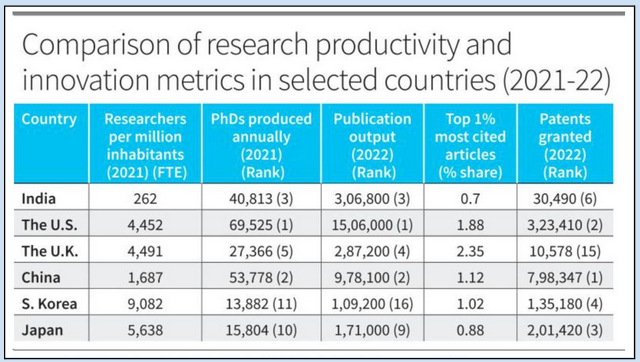India’s R&D funding, breaking down the numbers
Relevance: GS Paper III
Why in News?
The interim Budget for 2024-25 has announced a corpus of ₹1 lakh crore to strengthen India's research and innovation ecosystem.
Current landscape of Research and Development (R&D):
- The rebranding of the slogan, 'Jai Jawan Jai Kisan', to 'Jai Jawan, Jai Kisan, Jai Vigyan, Jai Anusandhan' is intended to reinforce the foundation of research and innovation for development.
- Research and innovation fuel economic growth, technological advancement, and global competitiveness.
- India's R&D is witnessing significant growth, with a notable increase in Gross Expenditure on Research and Development (GERD) from ₹6,01,968 million in 2010-11 to ₹12,73,810 million in 2020-21.
- However, with research and development investment as a percentage of GDP standing at 0.64%, India falls behind major developed and emerging economies such as China (2.4%), Germany (3.1%), South Korea (4.8%), and the United States (3.5%).
- Despite the comparatively lower share of GDP dedicated to R&D, India has emerged as a powerhouse in producing academic talent.

Research output, innovation:
- India has comparatively lower R&D expenditure as a percentage of GDP alongside its noteworthy output in terms of patent grants, PhDs awarded, and publication outputs.
- India generates an impressive 40,813 PhDs annually and is in third place after the United States and China.
- India's research output remains substantial, ranking third globally with over 3,00,000 publications in 2022.
- India also demonstrates commendable performance in patent grants, securing the sixth position globally with 30,490 patents granted in 2022.
- While this figure is lower compared to the U.S. and China, it underscores India’s evolving innovation landscape and its potential for further growth in intellectual property creation.
Investment in R&D:
- In India, GERD is primarily driven by the government sector, including the central government (43.7%), State governments (6.7%), Higher Education Institutions (HEIs) (8.8%), and the public sector industry (4.4%), with the private sector industry contributing only 36.4% during 2020–21.
- Collaboration between the government, business enterprises, and HEIs is essential to maximise the positive impact of science, technology, and innovation on economic growth and technological advancement.
- According to the R&D statistics (2022-23) of the Department of Science and Technology, India's total investment in R&D reached $17.2 billion in 2020-21, with 54% ($9.4 billion) allocated to the government sector and predominantly utilised by four key scientific agencies:
- Defence Research and Development Organisation (30.7%)
- Department of Space (18.4%)
- Indian Council of Agricultural Research (12.4%)
- Department of Atomic Energy (11.4%).
Government funding vis-a-vis Private funding:
- A significant portion of R&D funding originates from the government, with considerable allocation directed towards autonomous R&D laboratories operated by the government.
- These laboratories serve a pivotal role in driving research and technology development with strategic implications.
- This symbiotic relationship between government funding, R&D execution, and strategic focus underscores the integral role of the government in steering and fostering key scientific advancements.
- The contribution of private industries lags behind that of many other economies.
- At approximately $6.2 billion, Indian businesses represent 37% of the country’s GERD, in contrast to the global trend, where business enterprises typically contribute over 65% of R&D.
- In leading innovative economies such as China, Japan, South Korea, and the U.S., a significant portion (>70%) of R&D funding is from private industries, driven by market forces and profit motives, and the actual R&D activities are conducted in the HEIs.
- In India, however, HEIs play a comparatively minor role in the overall R&D investment, contributing 8.8% ($1.5 billion).
Impact of initiatives:
- National Deep Tech Startup Policy (NDTSP): It signals a strong commitment to technological progress and innovation.
- This policy can potentially incentivise private sector engagement in India’s R&D ecosystem.
- Despite the substantial time and technical uncertainties involved in Deep Tech’s creation, allocating resources to safeguard intellectual property and tackle technical obstacles can unlock untapped markets.
- Anusandhan National Research Foundation (ANRF) Act: The recent enactment of the act underscores the government's dedication to catalysing research and innovation as the cornerstone of development.
- It aims to bridge India’s persistent R&D investment gap while nurturing a robust research culture within HEIs.
- This legislative move will bolster scientific research nationwide.
- Although promising, this initiative must surmount challenges such as ensuring equitable fund distribution, fostering interdisciplinary collaborations, and upholding global standards.
- Interim Budget (2024-25): Combined with the NDTSP and ANRF Act, it sends positive signals regarding India’s commitment to incentivising private sector-led research and innovation, particularly in burgeoning industries.
Way forward:
- Incentivising private sector investment: India must implement policies that incentivise private companies to invest in R&D. It is important to recognise that increasing industry contribution to R&D is a complex issue with no single solution.
- Dual Strategy: India's technological and manufacturing aspirations hinge on a transformative shift in its R&D landscape.
-
- Closing the existing gap requires a dual strategy: encouraging private sector involvement and fortifying academia's research infrastructure.
- Multi-pronged approach: It requires the involvement of diverse stakeholders to address the challenges and unlock the potential of R&D for India's economic growth and competitiveness.
- Elevating budgetary spending: It will provide strategic guidance for research, innovation, and entrepreneurship while encouraging greater private-sector involvement.
- Replicating global best practices: Learning from the R&D ecosystem in other developed countries while maintaining India’s streamlined decision-making and strategic alignment strengths could be a powerful force to optimise its R&D landscape.
Conclusion:
India’s R&D ecosystem has advantages in terms of efficiency, but it could benefit more from strong private enterprise involvement and stronger industry-academia collaboration, which would facilitate knowledge transfer and foster innovation.


